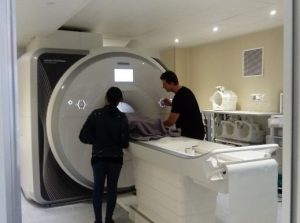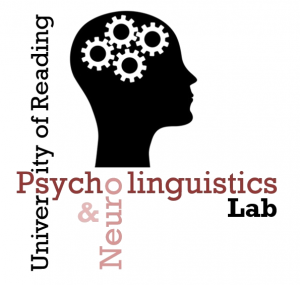 Our research in the cognitive neuroscience of language has two main strands that are both closely linked to our work in Sentence Processing and Bi-/Multilingualism. One strand of research in neurolinguistics utilises EEG and MRI to investigate language processing in different populations of speakers, while a second strand utilises MRI to investigate how bi-/multilingualism influences brain structure and function.
Our research in the cognitive neuroscience of language has two main strands that are both closely linked to our work in Sentence Processing and Bi-/Multilingualism. One strand of research in neurolinguistics utilises EEG and MRI to investigate language processing in different populations of speakers, while a second strand utilises MRI to investigate how bi-/multilingualism influences brain structure and function.
The lab has its own Brain Products actiCAP EEG system for running ERP experiments. We also have close links to the Centre for Integrative Neuroscience and Neurodynamics, which houses additional EEG systems along with facilities for TMS and MRI.
Representative Publications
Korenar, M., Treffers-Daller, J. and Pliatsikas, C. (2023). Brain structure adapts dynamically to highly demanding bilingual experiences: insights from interpreters and translators. Ampersand, 11, 100148.
Korenar, M., Treffers-Daller, J. and Pliatsikas, C. (2023). Dynamic effects of bilingualism on brain structure map onto general principles of experience-based neuroplasticity. Scientific Reports, 13, 3428.
Marin-Marin, L., Costumero, V., Ávila, C. and Pliatsikas, C. (2022). Dynamic Effects of Immersive Bilingualism on Cortical and Subcortical Grey Matter Volumes. Frontiers in Psychology, 13, 886222.
Voits, T., Robson, H., Rothman, J. and Pliatsikas, C. (2022). The effects of bilingualism on hippocampal volume in ageing bilinguals. Brain Structure and Function, 227, 979–994.
Cheng, Y., Cunnings, I., Miller, D. & Rothman, J. (2021). Double-number marking matters for both L1 and L2 processing of non-local agreement similarly: An ERP investigation. Studies in Second Language Acquisition.
Pliatsikas, C. , Ansaldo, A. I. and Voits, T. (2021). Bilingualism and the declining brain. Linguistic Approaches to Bilingualism, 11, 453-458.
Pliatsikas, C. , Pereira Soares, S. M., Voits, T., DeLuca, V. and Rothman, J. (2021). Bilingualism is a long-term cognitively challenging experience that modulates metabolite concentrations in the healthy brain. Scientific Reports, 11. 7090.
Pliatsikas, C. (2020). Understanding structural plasticity in the bilingual brain: The Dynamic Restructuring Model. Bilingualism: Language and Cognition, 23, 459-471.
Pliatsikas, C., DeLuca, V. and Voits, T. (2020). The many shades of bilingualism: language experiences modulate adaptations in brain structure. Language Learning, 70, 133-149.
Pliatsikas, C. , Meteyard, L. , Veríssimo, J., DeLuca, V. , Shattuck, K. and Ullman, M. T. (2020). The effect of bilingualism on brain development from early childhood to young adulthood. Brain Structure and Function, 225, 2131-2152.
Voits, T., Pliatsikas, C. , Robson, H. and Rothman, J. (2020). Beyond Alzheimer’s disease: can bilingualism be a more generalized protective factor in neurodegeneration? Neuropsychologia, 147, 107593.
DeLuca, V., Rothman, J., Bialystok, E. and Pliatsikas, C. (2019). Redefining bilingualism as a spectrum of experiences that differentially affects brain structure and function. Proceedings of the National Academy of Sciences of the United States of America, 116, 7565-7574.
DeLuca, V., Rothman, J. and Pliatsikas, C. (2019). Linguistic immersion and structural effects on the bilingual brain: a longitudinal study. Bilingualism: Language and Cognition, 22, 1160-1175.
Leminen, A., Smolka, E., Duñabeitia, J. A. and Pliatsikas, C. (2018). Morphological processing in the brain: the good (inflection), the bad (derivation) and the ugly (compounding). Cortex, 116, 4-44.
Roberts, L., González Alonso, J., Pliatsikas, C. and Rothman, J. (2018). Evidence from neurolinguistic methodologies: can it actually inform linguistic/ language acquisition theories and translate to evidence-based applications? Second Language Research, 34, 125-143.
Pliatsikas, C., DeLuca, V., Moschopoulou, E. and Saddy, J. D. (2017). Immersive bilingualism reshapes the core of the brain. Brain Structure and Function, 222, 1785-1795.
Pliatsikas, C., Johnstone, T. and Marinis, T. (2017). An fMRI study on the processing of long-distance wh-movement in a second language. Glossa: A Journal of General Linguistics, 2, 101.
Pliatsikas, C. and Luk, G. (2016). Executive control in bilinguals: a concise review on fMRI studies. Bilingualism: Language and Cognition, 19, 699-705.
Pliatsikas, C., Moschopoulou, E. and Saddy, J. D. (2015). The effects of bilingualism on the white matter structure of the brain. Proceedings of the National Academy of Sciences of the United States of America, 112, 1334-1337.

